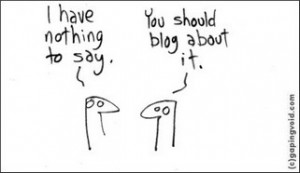 Over the past fifteen years the word “blog” has become part of our daily vocabulary and most of us visit some form of blog on a daily basis. In some cases we’re not even aware of the fact that it’s a blog. Since the emergence of blogs in the late 1990’s their appearance and functions changed and developed.
Over the past fifteen years the word “blog” has become part of our daily vocabulary and most of us visit some form of blog on a daily basis. In some cases we’re not even aware of the fact that it’s a blog. Since the emergence of blogs in the late 1990’s their appearance and functions changed and developed.
A Blog (combination of the words “web” and “log”) is a website that contains stories and updates in reverse chronological order–the most recent entries appear at the top of the front page, and you browse backwards to move through the past articles.
A typical blog combines text, images, and links to other blogs, Web pages, and other media related to its topic. The ability of readers to leave comments in an interactive format is an important contribution to the popularity of many blogs. Through the sharing of information the blogger builds a relationship with his readers or followers and a virtual community of like minded people with similar interests is cultivated.
The emergence of blogs changed the face & future of journalism to a large extent. Suddenly anyone with access to a pc, was able to publish their opinions and writings. Most blogging platforms are extremely user friendly and makes it easy for individuals without web design experience to have their blog at no cost whatsoever.

Initially blogs were about personal experiences and maintained by a single person as a form of self expression or commentary on certain topics. These blogs were initially made possible by sites like Open Diary, Live Journal and Blogger. By the late 2000’s the focus shifted from blogs as personal diaries to full blown, edited and moderated digital magazines. “Multi-author blogs” started developing, with posts written by large numbers of authors and professionally edited.
As the purpose of blogs shifted through the years, so did their format. Now we also have a scaled down version of the original blog format, the microblog. Microblogs consist of short commentaries or content, and photos, videos or other multimedia. Twitter and Tumblr are two of the more popular examples of microblogging and are especially useful when it comes to realtime updates of important global events.
If you’re feeling inspired and would like to create a blog for your department, you don’t have to look far. You can host your department’s blog locally on the university’s own WordPress platform. For more information, click here.
[SOURCE: www.howtogeek.com & www.wikipedia.org]
 Oor die afgelope vyftien jaar het die woord “blog” deel geword van ons daaglikse woordeskat. Jy besoek daagliks een of ander vorm van `n blog en besef dit nie eers nie! Sedert blogs of webjoernale hul verskyning gemaak het in die laat 90’s, het die formaat en funksionaliteit geleidelik verander en ontwikkel.
Oor die afgelope vyftien jaar het die woord “blog” deel geword van ons daaglikse woordeskat. Jy besoek daagliks een of ander vorm van `n blog en besef dit nie eers nie! Sedert blogs of webjoernale hul verskyning gemaak het in die laat 90’s, het die formaat en funksionaliteit geleidelik verander en ontwikkel.
`n Blog (kombinasie van die woorde “web” en “log”) is `n webwerf bestaande uit artikels en stories, gelys in omgekeerde chronologiese volgorde van bo na onder. Jy kan dus blaai deur die inskrywings van nuwe artikels na oud.
`n Tipiese blog bestaan uit teks, grafika en skakels na ander blogs, webwerwe en media verwant aan die blog se gekose onderwerp. Die vermoeё van lesers om op interaktiewe wyse kommentaar te lewer, `n belangrike faktor wat bydra tot die populariteit van blogs. Deur middel van die deel van inligting bou die blogskrywer `n verhouding op met sy lesers en `n virtuele gemeenskap met `n eendersdekende lede met dieselfde belangstellings word gekweek.
Die verskyning van blogs het die toekoms en definisie van joernalistiek op `n beduidende wyse beinvloed. Skielik kon enigiemand met toegang tot `n rekenaar sy opinies en artikels publiseer sonder om geredigeer te word. Die meeste blogplatforms is besonder gebruikersvriendelik en maak dit vir individue sonder webontwerp-ondervinding moontlik om kosteloos hul eie blog te hê.

Aanvanklik was blogs hoofsaaklik oor persoonlike ondervindings en onderhou deur `n enkele persoon as `n vorm van selfuitdrukking of kommentaar op sekere onderwerpe. Hierdie blogs is moontlik gemaak deur webwerwe soos Open Diary, Live Journal and Blogger. Teen die laat 2000’s is die fokus verskuif van blogs as persoonlike dagboekinskrywings na volwaardig geredigeerde en gemodereerde digitale tydskrifte. “Multi-skrywer blogs” begin ontwikkel. Bloginskrywings word geskryf en professioneel geredigeer deur groot groepe skrywers.
Soos die funksie van blogs met tyd verander, pas die formaat ook aan. Bo en behalwe tradisionele blogs, ontstaan daar ook afgeskaalde weergawes van die oorspronklike formaat in die vorm van die mikroblog.
Mikroblogs bestaan uit korter kommentaar of inhoud, fotos, videos of ander multimedia. Twitter en Tumblr is twee van die mees populêre voorbeelde van mikroblogs en is veral nuttig vir intydse opdaterings van belangrike globale gebeure.
As jy geinspireerd voel en `n blog vir jou departement wil begin, hoef jy nie ver te soek nie. Jy kan op die universiteit se eie WordPress-platform registreer en jou loopbaan as `n blogger begin! Vir meer inligting, kliek hier.
[SOURCE: www.howtogeek.com & www.wikipedia.org]
Tags: blog

